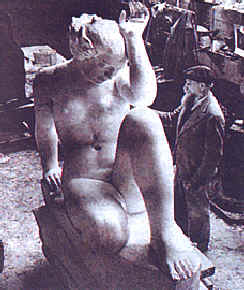William Grimes's obituary from the New York Times, January 27, 2009:
Dina Vierny, the model whose ample flesh and soft curves inspired the sculptor Aristide Maillol, rejuvenating his career, and who eventually founded a museum dedicated to his work, died on Jan. 20 inParis
Her death was announced by the Fondation Dina Vierny-Musée Maillol, which she founded in 1995.
In the same period when she was modeling, Ms. Vierny, who had joined the Resistance early on during World War II, led refugees from Nazism across the Pyrenees intoSpain
Dina Vierny, the model whose ample flesh and soft curves inspired the sculptor Aristide Maillol, rejuvenating his career, and who eventually founded a museum dedicated to his work, died on Jan. 20 in
Her death was announced by the Fondation Dina Vierny-Musée Maillol, which she founded in 1995.
In the same period when she was modeling, Ms. Vierny, who had joined the Resistance early on during World War II, led refugees from Nazism across the Pyrenees into
Ms. Vierny was a 15-year-old lycée student in
“Mademoiselle, it is said that you look like a Maillol and a Renoir,” Maillol wrote to her. “I’d be satisfied with a Renoir.”
For the next 10 years, until his death in a car accident in 1944, Ms. Vierny was Maillol’s muse, posing for monumental works of sculpture that belied her modest height of 5 feet 2 inches. By mutual agreement, the relationship was strictly artistic.
Maillol threw himself into his sculpture with renewed energy and, at Ms. Vierny’s urging, began painting again. After his death, she worked tirelessly to promote his art and enhance his reputation, eventually creating the
Ms. Vierny was born in
Ms. Vierny, who was intent on studying physics and chemistry, took to the role of artist’s muse reluctantly at first, posing during school vacations and glancing sideways at her schoolbooks on a nearby stand. The generous modeling fees and Maillol’s sense of fun won her over.
For the first two years, though, she kept her clothes on, not out of modesty — she and her friends belonged to a nudist club — but because of Maillol’s timidity. She herself later proposed that he try some nude studies. “Since he never asked, I figured he would never have the courage,” she told National Public Radio last year.
Her Rubenesque figure and jet-black hair indeed made her, as Dondel had predicted, “a living Maillol,” memorialized in works like “The Seated Bather,” “The Mountain,” “Air,” “The River,” and “Harmony,” his last, unfinished sculpture. Maillol also turned to her as a subject for drawings and painted portraits, like “Dina With a Scarf,” now in the
In 1939, Maillol took refuge at his home in Banyuls-sur-Mer, at the foot of the eastern
Ms. Vierny soon began dozing off at her posing sessions. The story came out, and Maillol, a native of the region, showed her secret shortcuts, smugglers’ routes and goat paths to use. After several months of working for the Comité Fry, Ms. Vierny was arrested by the French police, who seized her correspondence with her friends in the Surrealist movement but failed to notice stacks of forged passports in her room.
A lawyer hired by Maillol won her acquittal at trial, and to keep her out of harm’s way the artist sent her to pose for Matisse in Nice. “I am sending you the subject of my work,” Maillol told Matisse, “whom you will reduce to a line.”
Matisse did several drawings and proposed an ambitious painting that he called a “Matisse
She also posed for Dufy and for Bonnard, who used her as the model for “Somber Nude.”
In 1943, Ms. Vierny was again arrested, this time by the Gestapo, in
After the war, Ms. Vierny opened an art gallery in
A passionate and unpredictable collector, Ms. Vierny accumulated no fewer than 90 antique carriages, including the omnibus that Toulouse-Lautrec used to pick up his friends and the carriage used by Chateaubriand when he was ambassador to
In the early 1970s, Ms. Vierny decided to start a Maillol museum. She began buying up apartments on the Rue de Grenelle in
It was at the museum that Ms. Vierny lived the rest of her life. She is survived by her two sons, Olivier Lorquin, the director of the
“One day, I was climbing up an almond tree and Maillol turned to my father,” Ms. Vierny told The Independent of








No comments:
Post a Comment